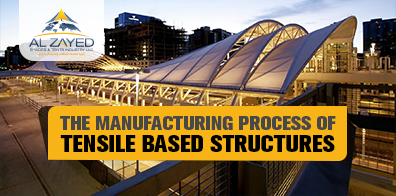
While member and tensile-based structures are not designed differently, they are manufactured in ways that are poles apart. Once the design phase is completed, the drawing is transferred to a manufacturer, who strives to translate that drawing into a viable physical equivalent. This process is sub-divided into establishing a foundation, a supporting frame, and the membrane. In this article, you will learn about the manufacturing process of tensile-based structures in particular:
Flat membrane produced in rolls is converted into a continuous sheet, which is curved from both sides. If you want to reduce the number of phases, use membrane envelopes that increase the level of industrialization of construction. On the flip side, it will increase the number of factory build components that can only be assembled on-site. This increases the efficiency depending on the material and joints that you are using, as well as the quality of the finished product.
The profile obtained after flattening the 3D shape during the patterning process in design, is beefed up with extra material, which makes it ready for welding and joint realization. The cutting process is focused on two things; the aesthetics and the reduction of wastage. The shape of the patterned panel depends on the cutting lines, which are carved on a long thin sheet or strip. Usually, each strip is broken down to give the structure a triangular shape, which is later laid down on a plane.
When the fabricator receives raw material from suppliers, they can subject it to different treatments or even change its color. Tests are conducted to control the material specifications. To prevent local damages, strips of fabrics are cut out from the roll in lengths running the gamut from 1.8m to 3.0 meters. These strips are joined together to create one long roll that is transportable and mountable. This saves you the need of welding and using expensive, more accurate processes.
Generally, the seams between the fabrics are bonded together by high frequency welding or by applying heat. This renders the fabric moisture resistant, and gives it extensive air tightness capabilities.
Although, you can bind the seam with glue or stitch the fabric with the seam, this only works for certain situations. Thanks to its mobile nature and low transportation costs, you can easily transport it via railways, waterways and airways. However, one needs to exercise caution as the membrane can easily be impaired in case an inaccurate folding process is employed. Therefore, you should keep the maximum foldable limit of the material in mind before attempting to move it. Keep a firm eye on the rigid elements especially, because they can damage the protective layer of the fabric or even lacerate it. This is very important if you are using PTFE or glass fabrics. These materials need cushioning during transport to avert any damages along the way.
Once the structure reaches the site, the assembly process is quick and efficient from there, thanks to rigorous International accuracy standards followed by manufacturers. The boundary details can be adjusted and the weights and volumes manipulated, so it diminishes the efforts required to lift the structure and mount it. Since you have a vast choice of vehicles for the process, you can save up on transportation costs. Additionally, you can try different material combinations such as steel, reinforced concrete, wood, and aluminum to name just a few.
After reading this article, you must be well acquainted with how these tensile-based structures are manufactured, but remember that the process may vary based on a number of factors. For instance, your choice of material plays an important role in determining how it will be manufactured and how you should handle it to keep it safe from damages. You can also customize the color and shape of the tent during the manufacturing process to tailor it to customer specifications. Knowing the pros and cons of each manufacturing process and the implications it will have on the final product can go a long way towards helping you select the right process.
Which manufacturing process is best according to you and Why? Feel free to share it with us in the comments section below.